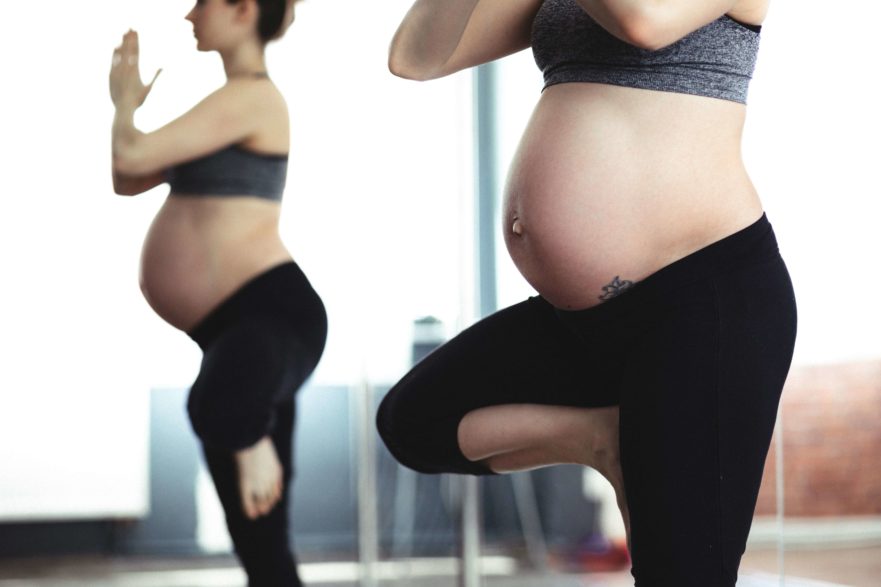
10th March 2020
Many women first encounter yoga classes when pregnant and yoga can indeed be highly beneficial bringing that mind, body, spirit connection as well as helping with mood, stress and anxiety, helping the mother-to-be with relaxation and breath techniques both in class and in preparation for birth.
With significantly increased blood in the body as well as weight gain and the overall bulk of carrying a child, the mother can feel quite sluggish and a yoga practise can help bring energy and improve circulation. Yoga can also help increase the strength and flexibility of the muscles needed for childbirth and bring some relief to lower back pain.
But what should be embraced and what should be avoided in pregnancy?
One key concern is the impact of elastin, the hormone that softens the ligaments around the pelvis in preparation for birth. The pelvis and hip joints and lower back can be vulnerable to being over stretched meaning that strong yoga practice and some asanas should be avoided. This can be a particular challenge for women who are naturally very bendy who are more susceptible to pelvic girdle pain.
Some do’s and don’ts for pre-natal yoga
- Twists – upper chest and shoulders only. The overall principle is not to compress or rotate the abdomen (and baby)
- Forward bends – best worked with wide legs (either seated or standing). Use the thighs for support and bend the knees if you like. As the pregnancy progresses heartburn can be an issue so adapt postures such as Child to have the head raised on blocks. Use a chair for support in some postures.
- Backbends – deep backbends are best avoided. Transferring standing to seated backbends such as a seated cat / cow provide better support and don’t hold a bend for long – keep it nice and fluid. A gentle bridge can be used, and do use props such as a bolster to help relax the body and facilitate the chest and shoulders to open.
- Inversions – the British Wheel of Yoga advise no inversions until week 15. When you are inverted (for instance downward dog or standing forward fold) ensure that holds are short. Legs up the wall can be a lovely restorative pose, especially for fluid retention.
- Lateral stretches – as with most postures keep them gentle and not too deep. Asanas such as a side stretch can feel good to try. With postures such as Triconansana (Triangle) take a shorter stance and don’t go as deep as usual. The feet may also be positioned parallel to the short edge of the mat rather than at the usual angle. Adapting a posture such as Half Lord of the Fishes to an open armed gentle twist can work well.
- Balances – Use a wall or chair for support. Eagle pose should be fine (perhaps do not lean forwards as your centre of gravity will be different and this can compress the abdomen). Dancer can be practiced without the full forward bend. Avoid postures such as Warrior 3 or Aeroplane.
- Squats – are great preparation for labour and birth
- Abs work – avoid work on the abdominals during pregnancy and as advised for the first few weeks following childbirth
- Pranayama – avoid breath retention. Do not practice Bhastrika or Kapala Bhati – be gentle on the diaphragm and abdomen. Explore upper chest breathing as space becomes compressed elsewhere. During asanas breathing out through the mouth may become necessary.
The gentle hum of Bee breath (Bhramari) or the Ohm chant can be very restful and babies seem to respond to the soothing vibrations and enjoy their sonic massage. - Bandhas – Only work with the mula bandha / pelvic floor and not the other bandhas. In pregnancy yoga we tend to exhale to soften a bandha and inhale to tighten (the opposite way to normal)
- Savasana – as the pregnancy progresses savasana (and sleep) should be done resting on the left side (almost in the recovery position) with supports for the head and perhaps a block between the knees
General advice for pregnancy yoga
If you don’t have an established yoga practice before pregnancy my advice would be to seek out a pregnancy-specific class rather than a general class. The British Wheel of Yoga do not advise starting yoga for the first time until 15 weeks have passed.
Avoid deep or challenging postures particularly if they are new to you.
Be kind to your body and keep your practise gentle with slow movements especially towards the end of the pregnancy. As the baby begins to take more space in the belly, avoid prone postures lying on the front.
Trust your intuition with your body. Go to your edge and then back off – don’t over stretch.
As the pregnancy progresses into the second and third trimester adopt a wider stance in normal standing postures and a narrower than usual stance in wide legged postures.
I am grateful to the amazing Amanda Mackenzie of Yogaroma who led a recent pregnancy yoga workshop I attended. The guidance above is all from that class.
Please be aware that this article does not constitute medical advice and if in any doubt consult a doctor or pregnancy yoga specialist.
Marie